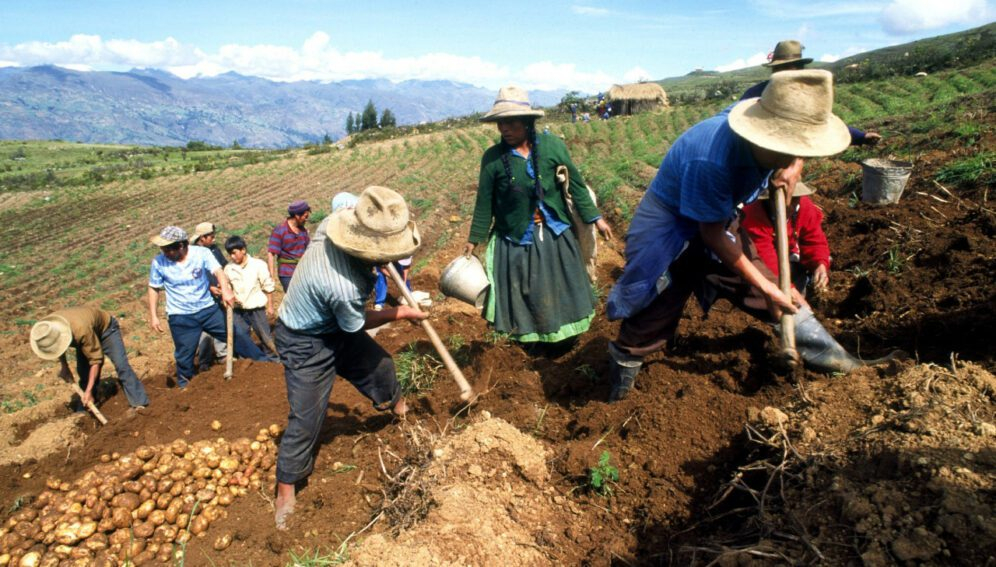
Peruvian agriculture is mired in a deep crisis. COVID-19, the fertilizer crisis and climate change have successively hit the sector, with family farming being the most affected due to the insufficient and short-term response of the Peruvian State, warned the new research “Family farming in times of crisis in Peru: diagnosis and recommendations” from Oxfam in Peru.
Since 2020, family farmers have suffered from successive crises in the country that led to a worrying increase in poverty: 41% of agricultural households are in poverty, almost double that of non-agrarian households, according to calculations from the study with based on INEI data.
In this research, economists Eduardo Zegarra and Yeni Vásquez analyze the impacts of these crises on family farming until mid-2023, as well as the State’s responses and possible alternatives to confront it with a view from agricultural organizations.
Poverty affects families that live from agriculture more
The successive crises have deepened the historical inequality gaps, particularly in regions with greater agricultural activity, with levels higher than the national average. “In 2022, poverty affected 42% of agricultural households, a figure that will increase this year due to serious climate events,” said the economist and author of the study, Eduardo Zegarra.
“It is a sector that has not received adequate public policy attention in the last 30 years. If the abandonment of family farming continues, this sector in which 1 in 5 Peruvians live will continue to become poorer and will have less and less production capacity for important foods such as tubers, vegetables, fruits, Andean grains and milk, which “They are key to national food security.”
Insufficient and short-term response from the State
Only 3.5% of Peru’s public budget is allocated to the agricultural sector, in which export or business agriculture is prioritized, with large water projects on the coast of Lambayeque, Ica and La Libertad. According to the research, what remains for family farming is a limited fraction that has been ineffective in alleviating the adverse effects of the crises of recent years.
“The budget assigned to the sector has not proven to be effective in mitigating the adverse impacts that farmers have been facing,” emphasized Alejandra Alayza, head of Oxfam in Peru. “It is vital to design agile and efficient policy instruments to serve the producer population in crisis situations.”
The agricultural organizations consulted in the investigation confirm that the measures dictated by the State against COVID-19, the fertilizer crisis and climate change were insufficient, ineffective and even short-term.
In the health emergency, one of those measures was the Rural Bonus, which was allocated to rural families in poverty, that is, 42% of the rural population. But almost 60% of rural families (1.3 million families) that had been suffering the harsh impacts of the economic paralysis were left out, the research warns.
The state response was also limited in the fertilizer crisis. Added to the frustrated purchase of urea in 2022 were the serious problems of design and implementation of the SafeAgro, Wañuchay and Fertiabono bonds, where the lack of an updated register of producers was an obstacle to the effectiveness of said economic aid.
Regarding the State emergency declarations due to droughts and floods, these were made without allocating an additional budget and it was also required to appear in the Register of Agricultural Producers to access the bonuses. As of May of this year, only 70% of the producer population at the national level has been registered.
The greatest impact on rural and indigenous women
The successive crises of recent years have had a greater impact on rural and indigenous women, who have had more difficulties in reducing poverty after the pandemic and are invisible within agricultural activity due to decades of institutional weakness and structural machismo within and outside the territories.
Although they represent 30% of the productive population in the agricultural sector, the creation of policies and programs aimed at addressing their needs and gender gaps in the agricultural sector is still incipient. The first advances were made only in 2021 with the promulgation of Law No. 31168 that creates the Directorate for the Promotion of Women Agricultural Producers and the Entrepreneurship Fund for Rural and Indigenous Women.
“Although it is an important first step, it cannot yet be said that the sector is implementing a comprehensive policy in favor of agrarian, rural and indigenous women with relevant intercultural and geographical considerations,” said Alejandra Alayza, head of Oxfam in Peru.
“It is necessary that the budget be designed incorporating the gender perspective, which will allow resources to be allocated to the empowerment of women in the sector, avoiding depending exclusively on a particular fund,” added Alayza. She added that “it is also important that unions and other organizations recognize that rural and indigenous women sustain life, take care of lands and territories, natural resources, families and communities, even more so in scenarios as harsh and uncertain as the current one.” ”.
Source: Larepublica
Alia is a professional author and journalist, working at 247 news agency. She writes on various topics from economy news to general interest pieces, providing readers with relevant and informative content. With years of experience, she brings a unique perspective and in-depth analysis to her work.












